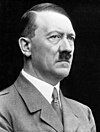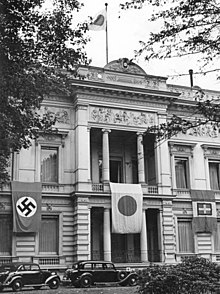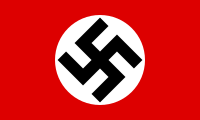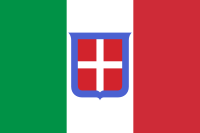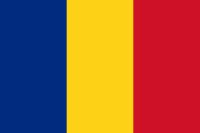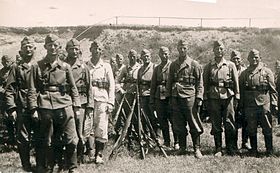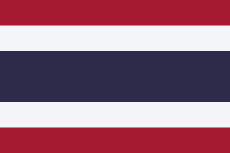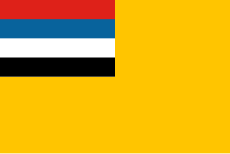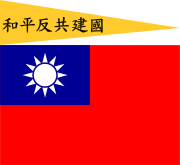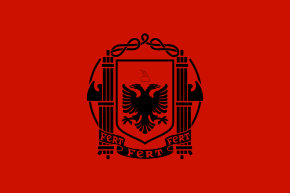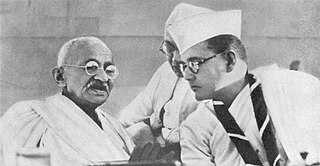Axis Powers in World War II
The Axis Powers —German: Achsenmächte; in Italian: Potenze dell'Asse; in Japanese: 樞軸國 Sūjikukoku—, also known as the «Rome–Berlin–Tokyo Axis» and by its acronym "Roberto" formed the belligerent side that faced the Allies in World War II. It was made up of Germany, the Empire of Japan and the Kingdom of Italy, and had the adhesion of other countries such as Romania, which stood out for having fought against the Soviets.
These nations signed the Tripartite Pact. This new bloc achieved its establishment due to the coincidences that existed between the government, economic and ideological systems of the three countries. Similarly, they shared three coincidences with a negative connotation: they were the countries most affected by the Treaty of Versailles.
Prelude
The phrase Rome-Berlin Axis was used for the first time by Benito Mussolini in November 1936, when referring to the friendship treaty signed on October 25, 1936 between the Kingdom of Italy and Germany Nazi, says that the two countries would form an Axis around which the other states of Europe would revolve. This pact of friendship was forged at the initiative of Italy, which was facing strong opposition in the League of Nations due to its occupation wars in Somalia and Abyssinia (Ethiopia), thereby gaining the support of Germany, which had already abandoned the League of Nations in 1933. Later, in May 1939, this relationship would become the alliance called the Pact of Steel and would finally also integrate Japan after the signing of the Tripartite Pact on September 27, 1940. In addition to the three great powers that give name to the pact, adhered to it: Kingdom of Hungary, Kingdom of Romania, Kingdom of Bulgaria and Slovakia, already separated from the rest of Czechoslovakia, by virtue of the Munich agreements of 1938.
Another country, considered by the allies as part of the Axis was Finland, although it never signed the treaty. In its relationship with the Nazis, Finland was considered a co-belligerent, a term that encompassed countries ruled by Nazi puppet governments such as Croatia, the Serbian National Salvation Government, the Independent State of Montenegro or Vichy France. Siam was another co-belligerent state, supporting the Empire of Japan, which in turn had a series of puppet governments such as Manchukuo (the government established by the Empire of Japan in Manchuria), Mengjiang, China nationalist Nanking, the Second Philippine Republic, Ba Maw Burma or the Provisional Government of Free India. The Kingdom of Italy had Albania and Abyssinia as puppet states.
In 1927 Mussolini had come to propose the formation of a so-called "Latin Bloc" that would group Italy, France, Spain, and Portugal and that would constitute an alliance based on the Latin civilization and the common culture between these nations. the proposal was publicly discussed between the governments of Italy, Spain and Vichy France during World War II, no alliance of this type was ever formalized.
Axis Powers
Germany
The term "Nazi" is a shortened form of "National Socialism" in German. This ideology was institutionalized in the National Socialist German Workers' Party (NSDAP), also known as the Nazi Party.
The Third Reich is the period and is used as a synonym for Nazi Germany. The term was introduced by Nazi propaganda, which counted the Holy Roman Empire as the First Reich or Empire, the German Empire (1871-1918) as the second, and his own regime as the third. This was done to suggest a glorious return to the former Germany after the Weimar Republic was established in 1919 and yet was never officially dissolved by the new regime.
The Nazi Party sought to combine traditional symbols of Germany with symbols of the Nazi Party, with a single symbol, the swastika being the most representative of the regime, in an effort to reinforce the idea of unity between its ideals and Germany.
Empire of Japan
The Empire of Japan (大日本帝国; Dai-Nihon/-Nihon Teikoku) commonly refers to Japan from the Meiji Restoration to the end of World War II. Politically, it covers the period from the imposition of establishing prefectures instead of feudal domains on July 14, 1871, through Japan's expansion into the Pacific and Indian Ocean, to the formal surrender on September 2, 1945 when it was signed. the Instrument of Surrender. Constitutionally, it refers to the period from November 29, 1890 to May 3, 1947.
The country was renamed the Empire of Japan, as the anti-Tokugawa, Satsuma, and Chōshū feudal clans formed the basis of its new government after the Meiji Restoration, with their intention of leaving it as an empire.
Although the Empire of Greater Japan is the literal translation of the title in Japanese, according to the Constitution of the Empire of Japan (大日本帝国憲法; Dai-Nihon/-Nihon Teikoku Kenpō), the names "Japanese Empire" and "Imperial Japan" are commonly known and used, referring to the same entity.
In Japan, the names "Nihon" (日本; 'Japan'), "Dai-Nihon" (大日本; 'Great Japan'), «Dai-Nihon/-Nihon Koku» (大日本国; 'Nation of Greater Japan'), «Nihon Teikoku» (日本帝国; 'Empire of Japan') were all used and it was not until 1936 that the proper title of the country was standardized.
In 1946, a year after the end of the war, Japan restructured itself as part of its defeat, and the country's title was once again corrected to "The State of Japan" (日本国; Nihon Koku ) in the draft within the Constitution of Japan.
Kingdom of Italy and its colonies
Fascism in Italy (which gave rise to so-called Fascist Italy) was a political movement of the 20th century that arose in Italy at the end of the First World War through the National Fascist Party founded by Benito Mussolini.
It was born partly as a reaction to the Bolshevik Revolution of 1917 and the strong union fights of workers and braceros that culminated in the red biennium, partly as a polemic regarding the liberal-democratic society that came out battered from the experience of the First World War.
The name derives from the Italian word fascio (Latin: fascis). The word, in ancient Rome, was used as a symbol of the union of fighters. The fascist symbol is the Roman fasces which signified the power of the regime, particularly jurisdictional power.
From 1943, with the allied invasion of the Italian Peninsula, the fall and arrest of Mussolini takes place and the position of the government of Pietro Badoglio with the allies is made, this in turn causes the German invasion of Italy, the liberation of Benito Mussolini that establishes the Italian Social Republic or Republic of Salò in the area occupied by the Germans. Meanwhile, in the zone liberated by the allies, the Kingdom of Italy continues this time in favor of the allies, with the consequent civil war between Italians. After the Surrender in 1943 and as a result of King Victor Emmanuel III's support for Mussolini, he abdicated at the end of 1943 to his son Umberto II, who acted as regent until the end of the war and in 1946 proclaimed himself King of Italy until the holding of the referendum establishing the current Republic of Italy.
Partners of the Axis
Kingdom of Hungary
Since 1920, Admiral Miklós Horthy had been Regent of Hungary. Through the Treaty of Trianon, that country had lost 72% of its historical territory in favor of the Kingdom of Romania, Czechoslovakia and the Kingdom of Yugoslavia. The increase in German influence over the Balkans before the war motivated Horthy to join Hungary to the Tripartite Pact in November 1940, after having received territories from Czechoslovakia and the Kingdom of Romania during the Vienna Arbitrations (1938 and 1940)..
Subsequently, the Hungarian armies participated in the invasion of Yugoslavia, receiving more territory for this. The eventual participation of the Kingdom of Hungary in the invasion of the Soviet Union was necessary to counteract the influence that the Kingdom of Romania was beginning to have over Germany. Mass deportations of Hungarian Jews to the death camps began in early 1944, but by then, the Jewish population had already been stripped of their basic rights through the application of racial laws.
When the tide of the war finally turned against Nazi Germany, Horthy attempted to negotiate a separate armistice with the Soviets, his son being his representative. Hitler found out about Horthy's plans and sent a commando headed by Otto Skorzeny to kidnap his son. The maneuver worked and Hungary remained on Germany's side until the end of the war. However, Horthy was replaced by Ferenc Szálasi, a philo-German of the Arrow Cross Party.
After the Battle of Budapest, the Hungarian government collapsed and Hungary was occupied by the Red Army, which turned the country into a socialist state. All Hungarian annexations during the war were declared null and void and Hungary regained its old borders, except for a few villages that were ceded to Czechoslovakia. After the war, Horthy managed to find refuge in Portugal, where he died. Szálasi did not suffer the same fate, since he was tried and executed by the communist authorities.
Kingdom of Romania
Since his accession to the Romanian throne in 1930, Carol II had initiated a series of dictatorial and repressive measures, being supported by the fascist movement known as the Iron Guard. In May 1939, the main members of the Iron Guard are arrested by Carol II, who, having enough power, had outlawed that violent and pro-German movement in 1933. Carol II had also abolished political parties and had initiated the application of measures anti-Semites in his government, even though he had not allied with Germany, in an attempt to repeat Romania's relatively successful policy of neutrality during World War I. However, swift Allied defeats in Poland and France left Romania in a delicate position, as it had no allies in a German-controlled region.
After the Soviet Union, the Kingdom of Hungary and the Kingdom of Bulgaria took over a third of Romanian territory in 1940, the reign of Carol II weakened. This weakness was taken advantage of by Horia Sima, leader of the Iron Guard, and General Ion Antonescu to force the king to abdicate on September 6, 1940. Antonescu then seized all power and, supported by the Iron Guard, invited German troops to occupy Romania; weeks later, Antonescu joined his country with the Axis.
After an Iron Guard revolt in January 1941, Antonescu sent many of its members into exile and increasingly relied on the Army to stay in power. He also continued Carol II's racial segregation measures and, as the war progressed, began a brutal, but not general, persecution of Romanian Jews. For this reason, many Jewish populations did not disappear in some regions of Romania, although their basic rights were denied.
In November 1940, Hitler announced to Antonescu his intention to invade the Soviet Union. Ten days before the start of the invasion, Hitler asked Antonescu for the participation of his troops in the campaign; therefore, the Kingdom of Romania sent nearly half a million soldiers to Operation Barbarossa, though many poorly trained and equipped. This was made clear in Operation Urano, which decimated the Romanian forces and created the terrible Stalingrad Kessel.
In about May 1944, the Red Army crossed the border into the Kingdom of Romania. The proximity of the enemy, the destruction of two Romanian armies, terrible inflation and the US air force bombing of Romanian oil wells, threatened to turn Romania into a battlefield, so on August 23, King Miguel I carried out a coup and dismissed Ion Antonescu. Immediately, the German troops were expelled from the Kingdom of Romania and the Balkans were opened to the soldiers of the Soviet Union.
The Kingdom of Romania was not treated as an ally by the Allies and, although it regained territory lost to Hungary in the summer of 1940, it did not regain territory ceded to the Soviet Union or Bulgaria. Ion Antonescu was tried and executed, and the German ambassador, Manfred von Killinger, responsible for a series of atrocities committed in the Kingdom of Romania, committed suicide. Romania was controlled by the Soviet Union after the war, and the monarchy was abolished in 1947.
Kingdom of Bulgaria
Since 1930, Tsar Boris III had initiated a series of measures challenging the League of Nations, following the German example, such as the creation of a Bulgarian air force. In February 1940, Bogdan Filov took the post of Prime Minister. Both the tsar and the prime minister were Germanophiles and tried to recover the borders lost in the treaties of Bucharest and Neuilly. Indeed, in September 1940, the Kingdom of Bulgaria succeeded in recapturing southern Dobruja from the Kingdom of Romania in the Craiova Agreements.
Although Bulgaria had become close to Germany during the Dobruja negotiations, Bulgaria's rulers still hoped they could retain their neutrality in the European conflict. However, their hopes were dashed below when German forces approached their border and requested permission to cross to invade Greece in early 1941. The Tsar agreed and the Kingdom of Bulgaria was from then on considered a member of the Axis. Finally, on March 1, the Kingdom of Bulgaria adhered to the Tripartite Pact and its alliance with Germany became official. However, Bulgarian participation in the war was limited, although it ended up annexing Greek and Yugoslav territory and managing to regain its outlet to the Aegean Sea.
The Bulgarian government refused to participate in the invasion of the Soviet Union in June 1941, an offensive that was not popular with the country's Slavic population. In August 1943, Boris died after returning from Germany and his successor, Simeon II, was still a six-year-old boy, so power fell to the Regency Council made up of Prince Cyril, the former President of the Council of Ministers Filov and the Minister of War Michov. These men were of the extreme right and their decisions were subject to Germany. However, Bulgaria continued to maintain relations with the Soviet Union and, although the Bulgarian government agreed to the mass deportation of Jews to concentration camps, in practice, the measure was never applied, except in a few cases, since the same agents Governments hindered the deportation work, carried out by Germans. The same did not happen with the communists, many of them persecuted and imprisoned.
On September 5, 1944, the Soviet Union began its invasion of the country; three days later Bulgaria switched sides and the regents were deposed. Bulgaria then began fighting Germany, sending half a million men to Yugoslavia. Bulgarian forces moved north into Austria and Hungary, where they made contact with British units on May 8, 1945.
After the war, a socialist regime was installed in the country and the tsar and the royal family were sent into exile. In the Treaty of Paris of 1947, Bulgaria returned the territories taken from Yugoslavia and Greece, but kept the southern Dobruja from Romania.
Cobelligerents
Finland
Annexed to the Russian Empire in 1808, Finland achieved its independence one hundred and ten years later (with a brief monarchical period, that of the Kingdom of Finland), taking advantage of the chaos of the Russian civil war, along with Poland, Ukraine and the Baltic States.
In 1939 the Soviet Union had annexed the eastern half of Poland and Finland feared for its autonomy. On November 30, 1939, Finland was invaded by the Red Army, but the result was not as expected. Finland put several enemy units in check and, although it was finally defeated, it won the right to negotiate a Peace Treaty, for which it lost almost 10% of its territory (see Winter War).
The Finnish defeat, the lack of international support and the continuous Soviet meddling in the internal affairs of the country, motivated its participation in the German invasion of the Soviet Union in 1941, as a method of settling scores with its neighbor.
In this new war, called the Continuation War, the Finnish participation together with Germany was voluntary, and for this reason, the Finnish units were not subordinated to the German objectives, and were limited to advancing a little beyond the borders before 1940. In addition, the Finns opposed the implementation of racist measures in their society and Jews were allowed to participate in the war, despite existing sympathies in the country for Hitler and fascism. The Finnish leader, Carl Gustaf Mannerheim, had his reasons for not trusting Germany, since they had done nothing to help them in the Winter War; in fact, in the Ribbentrop-Molotov Pact, Hitler had approved the invasion of Finland.
At the beginning of June 1944, the Germans were "swept away" from Lake Ladoga and the German troops stationed in Finland prepared their withdrawal from that country. Indeed, a few months earlier, Mannerheim had warned Germany that if the Germans lost control of Estonia, Finland would negotiate a separate peace with the Soviets. The Finnish threats were serious and on September 19 they negotiated an armistice. The Germans deployed in Finland retreated through Lapland and razed Rovaniemi in retaliation for the Finnish switch.
At the end of the war, Finland definitively recovered the 1940 borders except for some additional losses, such as the access to the Barents Sea. During the war, Finland lost some 86,000 soldiers, but managed to retain its independence from the Soviet Union.
Thailand
Thailand was a special ally of Japan, as it saw in that alliance an opportunity to expel the English and French from Asia, even though it saw Japan as a new enslaver. But in late 1944 after the removal of Prime Minister Plaek Pibulsonggram, Thailand decided to formally join the Allies against Japan.
Iran
Since 1928, the Shah of Persia, Reza Pahlavi, had tried to minimize British influence in his country. In 1932, Reza canceled an agreement with the Anglo-Persian Oil Company but, under pressure from the United Kingdom, he quickly signed another. However, little by little, Iran was strengthening its commercial relations with Germany, to the detriment of the British Empire.
The invasion of the Soviet Union in 1941 made Iran a strategic corridor for bringing resources to the Caucasus. However, the shah refused to allow the transport of weapons to the Soviet Union through his territory, claiming neutrality. On August 25, the British and Soviets invaded Iran, claiming in turn that the Germans in their territory were spies and that the shah planned to sell oil exclusively to Nazi Germany.
Riza was forced to abdicate and, after a period in Mauritius, traveled to South Africa, where he died in July 1944. Mohammad Reza Pahlavi was crowned on 16 September 1941 in place of his father and allowed the crossing of war materials through their territory to the north for the remainder of the war. In September 1943, Iran declared war on Germany as a requirement to join the United Nations. During the Tehran Conference, the United States guaranteed the new shah that his country would be free of foreign troops at the end of the war, however, the Soviet Union proclaimed two small socialist republics with the Iranian provinces of South Azerbaijan in 1945. In May In 1946, the Soviet Union abandoned the aforementioned provinces after receiving oil concessions. However, after the provinces were re-annexed by Iran, the concessions were revoked.
Kingdom of Iraq
At the beginning of World War II, the Kingdom of Iraq was ruled by the regent Abdul Ilah, since the future king, Faysal II, was a minor. Although Iraq had gained its independence in 1932, the British retained their military bases in the country and their troops could mobilize without restrictions. In addition, the kingdom had commercial responsibilities with the United Kingdom, without receiving much benefit for it.
Because of this, strong anti-British sentiment arose in the country, especially in the Army, and four nationalist generals began to conspire to overthrow the pro-British government. On April 3, 1941, the Iraqi generals carried out a coup and overthrew the regent, although they respected the monarchical system. General Rashid Ali was appointed Prime Minister and immediately requested military support from Germany in order to counter the imminent British attack. The Iraqis besieged the British air force base at Habbaniya, but the besieged managed to lift the encirclement. German aid was limited to sending some Luftwaffe bombers to bomb Habbaniya, without decisive results. A British landing in Basra began on April 18, and more troops arrived from Transjordan.
At the end of May, Baghdad fell into British hands and Rashid Ali and his government fled to Iran and then to Germany. An armistice was signed on May 31 and the pro-British Iraqi government was restored. Realizing that German planes had refueled in Lebanon and Syria during the Anglo-Iraqi War, the British proceeded to occupy those colonies as well, hitherto under the control of Vichy France. British troops left the Kingdom of Iraq in 1947.
Rashid Ali returned to Iraq in 1958 when the monarchy was finally abolished. There he tried to overthrow Abdul Karim Qasim, but failed and was sentenced to death; however, he was forgiven.
Collaborationist governments
Italian Social Republic (Italy 1943-1945)
During the invasion of Sicily, King Victor Emmanuel III became determined to act against Prime Minister Benito Mussolini. After the Fascist Grand Council passed a vote of no confidence, Mussolini was arrested on July 25, 1943. His successor, Pietro Badoglio, assured Hitler that the Kingdom of Italy would not abandon Germany, but on September 8, the Kingdom of Italy announced the signing of an armistice with the Allies. The German Army then occupied central and northern Italy and the order was given to rescue Mussolini, imprisoned in the Gran Sasso. The famous SS Otto Skorzeny rescued him on September 12 and he proclaimed the creation of the Italian Social Republic, also known as the Republic of Saló, since its capital was located in this town.
Mussolini began the creation of a new Italian Armed Forces, which did not exceed five divisions, under the command of Marshal Rodolfo Graziani. At the Verona Trial, five members of the Fascist Grand Council who had voted against Mussolini were tried and executed, including his son-in-law, Galeazzo Ciano. Mussolini's real authority was scant and he soon realized this, since all important decisions were taken from Berlin. After the German defeat in France, he fell into a depressed mood that worsened in the following months, as he realized the inevitable defeat.
On April 25, 1945, a general partisan revolt broke out in northern Italy and Mussolini's position became untenable. After the partisans declared the death penalty for all fascist leaders, Mussolini dissolved his government and tried to escape to Switzerland disguised as a German soldier. However, a group of partisans recognized it and captured it on April 27; he was executed the next day along with several of his ministers, who accompanied him in his frustrated flight. On April 29, 1945, Marshal Graziani, who had been captured by the Allies, signed by proxy the so-called surrender of Caserta, the official capitulation of the German troops in Italy, as well as the Army of the Italian Social Republic (the latter being Graziani's point of concern). This document sealed the end of the fascist republic.
Vichy France
"Vichy France" or "Vichy regime" is the informal name given to the regime established in part of French territory and in all of its colonies after the signing of the armistice with Nazi Germany within the framework of the Second World War.
The Vichy government, whose head of state was former World War I hero Marshal Philippe Pétain, was initially dominated by Pierre Laval until December 1940, when intrigues by French collaborators led to his resignation and his successor. Admiral François Darlan, also of pro-German tendencies. In fact, Pétain remained head of state thanks to his great popular prestige, which is why the Nazis insisted on keeping him as the maximum leader of the regime. Vichy France enjoyed a rather reduced practical autonomy because the occupied zone of France included the strategic industrial centers, the most populated cities, and the areas of greatest industrial and agricultural production; In addition to this, Hitler appointed a special ambassador to Vichy, Otto Abetz, to ensure that Vichy's internal policy remained in accordance with the objectives set by Germany.
The official name given to the regime was «French State» (État Français) because it formally constituted an interruption of the Third French Republic (while the name «Republic» disappears from the acts regime officials) for the constitutional changes that liquidated parliamentary democracy and established an authoritarian regime. The political system was framed in the authoritarian regimes of the time, and was indebted to corporatism, showing visible sympathy towards the ideology of fascism.
To maintain the appearance of an autonomous government, Laval decided to install the administrative headquarters of the collaborationist government in some large city in unoccupied France, but this was not possible due to security reasons and German pressure, so, with As the months passed, Vichy was tacitly determined to be the seat of government in practice, although it was never officially declared the "capital." The regime immediately imposed a series of fascist-inspired measures, persecuting Freemasonry and publicly repudiating the alliance with the United Kingdom and the parliamentary democracy of the Third French Republic; on July 10, 1940, a new regime structure was established, numerous articles of the 1875 Constitution were suspended, and the official name of the country was changed to the "French State" (État Français) to avoid the name "Republic". Philippe Pétain was proclaimed "head of the French State" and Laval held the position of president of the Council of Ministers.
In any case, Vichy lost what little autonomy it had after the unoccupied zone was invaded by German and Italian troops on November 11, 1942, whereupon Wehrmacht troops established their direct control over the entire French territory and displaced the French civil administration from command, although it (and the Pétain government) was maintained to maintain the fiction of an independent France and because it was convenient for Nazi interests that the Administration continue in French hands collaborators from Germany because of the human and material costs of setting up a purely German bureaucracy. Internal security and the police were left completely under the command of the Nazi Gestapo and what little independence the Pétain regime could still display disappeared.
However, the duration of this Government did not go beyond the presence of German troops in France and its dissolution occurred in August 1944, shortly after the liberation of Paris, when the Tudescos transferred Pétain, Laval and the other Vichy collaborators to the German town of Sigmaringen, where they remained as refugees until the end of the war, which put an end to the collaborationist regime. The conclusion of the war brought with it Petain's death sentence, later commuted to life imprisonment by General Charles de Gaulle; he died in prison on the island of Yeu in 1951. Laval fled to Spain, but was handed over to the Gaullist government and shot for treason in October 1945.
Bohemia and Moravia (Czech Republic)
After the German occupation of the Sudetenland in October 1938, the Czechoslovak government lost power, and the Slovak independence movement gained authority, sponsored by the Germans. On March 15, one day after the secession of Slovakia, Hitler declared the Protectorate of Bohemia and Moravia, which included most of the territory of the present-day Czech Republic, except the Sudetenland.
The Protectorate was nominally ruled by Emil Hácha, but he held no real power. Hácha initially protested against the authoritarian measures of Reichsprotektor Konstantin von Neurath, but the subsequent arrest of many of his friends and collaborators, as well as the futility of his opposition, would end Hácha's will, which would end up becoming a puppet of the government. German.
Unlike its president, the Czech resistance actively tried to free itself from the German invaders and organized various operations on its territory. The best known is the Anthropoid operation, where the Reichsprotektor Reinhard Heydrich, nicknamed "The Butcher of Prague", was assassinated. In 1943 Reichsprotektor Karl Hermann Frank sent tens of thousands of Czech workers to Germany to work as slaves in the arms industry. Shortly after, any industrial activity not related to the war was prohibited.
On May 11, 1945, Prague was occupied by the Red Army (see Battle of Prague) and Hácha was arrested, dying six weeks later of failing health. The Czech Republic received the Sudetenland and was united with Slovakia again, forming Czechoslovakia again, this time as a socialist state. By the end of the war, almost the entire Jewish population of the Czech Republic had died from war shortages (about 120,000) along with tens of thousands of Czechs (between 36,000 and 55,000).
Manchukuo
During the interwar period, the ROC was embroiled in a bloody civil war between warlords the Kuomintang and the Chinese Communist Party. This period of internal chaos was used by the Soviet Union and the Empire of Japan to continue their fight for control of Manchuria. The only Chinese opponent in Manchuria, Zhang Zuolin, was killed by the Japanese in 1928, when they blew up his train.
The Mukden Incident is used by Japan as an excuse to invade Manchuria in 1931 and declare the Greater Manchu state on February 18, 1932 as an independent entity from China. The last Emperor of China, Puyi, was placed in command of the new country, which was renamed the Greater Manchukuo Empire in 1934. The League of Nations refuses to recognize Manchukuo, and Japan defies the body by withdrawing from the League. same.
Manchukuo served as a supply of raw materials to Japan and as a base for its campaigns against China and the Soviet Union before and during World War II (see Second Sino-Japanese War and Battle of Khalkhin Gol respectively).
On August 8, 1945, the Soviet Union began its invasion of Manchukuo, coinciding with the atomic bombing of Hiroshima and Nagasaki by the United States. Emperor Puyi had no power over the Japanese and Manchu troops in his territory, and merely stayed in his palace during the invasion. When defeat was imminent, Puyi renounced the throne but did not escape. On September 8, the Red Army halted in Korea, having occupied Manchukuo in its entirety. Puyi was arrested and sent to a "re-education school" where he remained until 1960.
Collaborationist Chinese Regime
The Nationalist Government of Nanjing (traditional Chinese: 南京国民政府; pinyin: Nánjīng Guó Mín Zhèngfǔ), also called the Government of Wang Jingwei, was a puppet government of the Japanese Empire in the Republic of China, created in March 1940 and under the leadership of Wang Jingwei. Its official name was Republic of China (中華民國, Zhōnghuá Mínguó), but it is also sometimes called the Republic of China-Nanjing. Other names frequently used by historiography are "Wang Jingwei Regime" (汪精卫政权, Wāng Jīngwèi Zhèngquán) or simply "Regime of Nanking".
The government of Wang Jingwei was one of several "puppet states" of the Japanese during the Second Sino-Japanese War (1937-1945), and a rival to the government of Chiang Kai-shek, which was, with the namesake, National Governor of the Republic of China in Chongqing. Wang Jingwei was a member of the left wing of the Kuomintang (KMT), which had broken away from the Chiang government in March 1940 in repelling the Japanese invaders. Claiming to be the legitimate government of the ROC, it flew the same flag and included the same emblem as Chiang Kai-Shek's National Government. However, it is widely recognized as a puppet state and did not enjoy diplomatic recognition, exception among the states of the Anti-Comintern Pact.
The Nanjing Nationalist Government was theoretically a reintegration of various entities that Japan had established in north and central China, including the eastern Republic of China Reformed Government, the northern Provisional Government of the Republic of China, and the Mengjiang Government in Inner Mongolia. Nonetheless, both North China and Inner Mongolia remained relatively free of their influence.
Mengjiang
Mengjiang (Chinese: 蒙疆, Pinyin: Měngjiāng, Wade-Giles: Meng-chiang, Chinese postal system transcription: Mengkiang), officially known as the Mengjiang United Autonomous Government, was a puppet state created by troops from Japan in northern China in 1936 and existed until the end of World War II.
Mengjiang was made up of the ancient Chinese provinces of Chahar and Suiyuan which correspond to the central part of contemporary Inner Mongolia; Mengjiang was called by the Japanese Mengkukuo or Mongokuo, a mix between Manchukuo (another former puppet state in China) and Mongkyo its name in Japanese. The ruler was the Mongolian aristocrat Demchugdongrub, under full control of Japanese military advisers. The government capital was the town of Kalgan, present-day Hohhot. To emphasize the Mongolian nationalism that Japan was supposedly trying to stimulate, Mengjiajng was named after Genghiskhan (in commemoration of Genghis Khan).
Although Japan's goal in allowing the creation of Mengjiang was to leverage Mongol nationalism to the detriment of China, the state's population was made up of mostly ethnic Han Chinese (approximately 80%).
Croatia
Suppressed during the interwar period, the Croatian nationalist party Croatian Party for Rights became a terrorist movement known as the Ustasha. After the invasion of Yugoslavia at the beginning of 1941, by Germany, Hungary and Italy, these nations proceeded to divide the country. The Ustachá, led by Ante Pavelić, secured permission from the victorious nations to form a Croatian state, which included Bosnia and Herzegovina and much of present-day Croatia.
Then, the ustachá initiate the dissolution of the Serbian government. In response to the German and Croatian repression, two armed groups emerged: the chetniks (monarchist Serbs) and the partisans (communists). The Chetniks, after radicalizing their position, would persecute and kill Muslims and, especially, Croats. The partisans, led by Tito, would manage to obtain British support, who at the end of the war would hand over government officials and Ustasha soldiers along with their families. The partisans would subject them to a long death march, known as the Bleiburg massacre. More than 200,000 people, including women and children, were killed in this genocide. Ditches more than 3 kilometers long have been found, where the victims were buried after being executed.
Ante Pavelić managed to escape to Argentina, where he lived until 1957, when he was shot in the street by the secret police of the Yugoslav government. Pavelić survived the attack, but had to escape to Spain, where he died two years later, due to complications from his injuries.
Slovakia
After the Munich accords stripped Czechoslovakia of territory critical to the defense of its borders, the Czechoslovak government was left weakened. This weakness was taken advantage of by the Slovak parties, led by Prime Minister Josef Tiso, to demand greater autonomy within the newly renamed Czech-Slovak Republic. Irritated by the continued demands of him, the Czech authorities deposed him, and Tiso fled to Germany.
On March 13, 1939 Tiso was summoned to the emergency Reich Chancellery by Hitler, and there, Joachim von Ribbentrop presented false reports indicating the agglomeration of Hungarian troops on the Slovak border, whose final objective was the division of Slovakia between Poland and Hungary. Tiso was urged on the need to proclaim the birth of the Slavic State, protected by Germany, in order to stop this virtual aggression. Tiso did not want to make this decision on his own and immediately traveled to Slovakia, where the Slovak Diet, after reading the false reports, proclaimed Slovak secession from Czechoslovakia on March 14. Tiso was proclaimed prime minister and the next day the Czecho-Slovak state ceased to exist with the creation of the Protectorate of Bohemia and Moravia that included the Czech part of the former country.
The Slovak State, soon after renamed the Slovak Republic, always depended on Germany. Due to the "Mutual Protection Treaty between the German Empire and the Slovak State" foreign policy and the Slovak army were controlled by Germany. In this way, Slovakia sent soldiers to war against Poland, the Soviet Union, and declared war on the United Kingdom and the United States. However, the Slovak territory remained almost all its existence free of Tude troops, with the exception of a strip of land on the border with Germany.
After the failed Slovak National Uprising of 1944 against the Germans, they occupied the country militarily, so that the little autonomy of Slovakia disappeared. The Red Army, supported by groups of Romanians and Czechs pushed the Germans to the west. The fall of Bratislava into Soviet hands on April 4, 1945 determined the end of the Slovak Republic, which was immediately annexed to Czechoslovakia again.
Serbia
After the invasion of Yugoslavia, Germany took control of most of the territory that is now Serbia, including central Serbia and the eastern half of Vojvodina. To facilitate the administration of these territories, a regional administration government known as the Government of National Salvation was established, headed by General Milan Nedić, who had suspiciously been in command of the Yugoslav troops during the war. German invasion a few weeks ago. The Serbian state was concerned about the Yugoslav prisoners of war and refugees, among whom was Milan Kučan, and insisted on the release of many of the former, reaching favorable results. However, this Serb state allowed the application of racial laws on its territory and, eventually, the Jewish Serbs were exterminated.
Western Serbian territory was occupied in 1941 by the newly formed and brief Republic of Užice, where Yugoslav Partisans and Chetniks tried to cooperate without success. The Germans crushed their brief republic, but this did not mean the end of their movements, which would strengthen over time. An estimated 200,000 Serbs died in the war, mostly from German reprisals, as 100 Serbs were ordered to be killed for every German soldier killed.
From 1943 the partisans put the collaborationist Serbs in check, but the government was finally dismantled on October 4, 1944, when the Red Army, supported by the partisans, took control of Serbia. Many collaborationist Serbs escaped to Slovenia and Austria, but there they were captured and sent to prisons. General Milan Nedić himself was captured by the British, who returned him to Yugoslavia. Officially, Milan Nedić committed suicide by jumping out of a window in a prison in Belgrade.
Albania
After the First Balkan War, the Ottoman Empire lost control of Albania; Austria-Hungary, Serbia, and Italy wanted to extend their influence in the new state, or at least limit the influence of the other nations. In this way, Albania was established as a principality, which was later transformed into a republic through a coup.
In 1925 Ahmet Zogu was appointed prime minister and three years later proclaimed himself king under the name of Zog I, although the democratic system continued in force in the country. The first years of the reign of Zog I were of political stability, but the king decided to get closer to Italy, already dominated by Benito Mussolini. By 1934 Italy dominated Albania's economy, as well as many of its government bodies. Furthermore, the Albanian army was trained by Italians and the number of Italians settling in Albania as colonists had increased. Zog I then decided to reduce the Italian influence in his country and expelled the Italian instructors, in addition, he nationalized the Italian Catholic schools in the country.
On April 7, 1939, Italian troops invaded Albania, and Zog I fled with his family. Five days later the Albanian Parliament offered the crown to the Italian King Victor Emmanuel III, and Albania became a protectorate. All the Albanian ministries were merged with the Italian ones, as well as the army. Soon after, an Albanian militia was formed under the control of the Blackshirts.
Since then, Albania has been subordinated to Italian foreign policy decisions, withdrawing from the League of Nations on April 15, 1939. It declared war on France and the United Kingdom on June 10, 1940, and served as base for the Italian invasion of Greece at the end of 1940. In fact, when this failed, one third of Albania was occupied by Greece until the Germans arrived in the area and defeated it. After the invasion of Yugoslavia in 1941, Albania received parts of the territory of present-day Montenegro. Then King Victor Emmanuel III, on behalf of Albania, declared war on the Soviet Union and the United States in 1941 and 1942, respectively.
In 1943, after the Italian armistice, Victor Emmanuel III relinquished the Albanian crown and the Germans occupied Albania. Albanian volunteers were then integrated into the 21st SS Skanderbeg Mountain Division of the German Waffen-SS, which fought mainly against Enver Hoxha's communist partisans.
At the end of the war Enver Hoxha seized power in Albania, turning it into a socialist state. Interestingly, Albania was the only German-occupied country to experience a growth in the Jewish population. The Albanian population hid many Jews, and false documents were given to them in some cases. Attempts have been made to explain that, because Albanians are Muslims, they did not consider Jews "a problem", ie anti-Semitism was not widespread in the population.
Montenegro
For many centuries, Montenegro, as the Principality of Zeta, was ruled by a succession of dynasties. It obtained the international status of an independent nation at the Congress of Berlin and then became a kingdom. After World War I, Montenegro reached an agreement with Serbia to form a federation that concluded with the formation of the state known as the Kingdom of Serbs, Croats and Slovenes. With the end of World War II, this kingdom became the Socialist Federal Republic of Yugoslavia, where it would remain until its disintegration in 1992. With this change, Montenegro ceased to depend directly on Serbia (as happened between 1918 and 1941) gaining some autonomy as the Socialist Republic of Montenegro. Due to its characteristics as the smallest of the six republics that made up Yugoslavia, Montenegro received large contributions from the federal government, becoming a partially prosperous state.
During World War II Montenegro was occupied by Italy, which annexed the territory of the Bay of Kotor (the Venetian Cattaro) to Dalmatia until September 1943 and also established the Independent State of Montenegro in 1941. This fascist state (which lasted from 1941 to 1944) was the scene of a bloody civil war, especially when it came under the control of Nazi Germany in late 1943.
Special cases
Spain
Despite the ideological similarities between both regimes, Francisco Franco and Adolf Hitler were never able to reach an agreement for the effective entry of Spain into the war. The meeting they had in Hendaye was a complete failure, since neither the Führer was willing to cede French Morocco to the Caudillo nor was he willing to renounce his claims. Despite this, internal pressure promoted the sending of the Blue Division, presumably made up of volunteers, to support Germany on the eastern front. It must be said that, for their part, the Republicans who survived the Civil War lent their support to the Allies, including the Soviet Union. After the end of the Second World War, Spain was a recurring destination for numerous fascists as a refuge from the judicial processes that were opened.
Luxembourg
During World War II the Luxembourg government and monarchy were sent into exile by the German invasion of May 10, 1940, although German troops actually occupied the city on the night of May 9. During the war, Grand Duchess Charlotte broadcast messages, via the BBC, to give hope to the people of Luxembourg. The state was placed under military occupation until August 1942, when it was formally annexed by the Third Reich as part of the Gau Moselland. Luxembourgers were declared German citizens and 13,000 were conscripted for military service. About 2,848 Luxembourgers eventually died fighting in the German army. Measures to silence Luxembourg opposition to this annexation were followed by passive resistance at first, such as the Spéngelskrich (lit. "War of the Pins"), and refusing to speak German. While French was banned, many Luxembourgers resorted to reusing old Luxembourgish words, which led to a renaissance for the language. Other measures included deportation, forced labor, forced conscription, and, more drastic, internment and deportation to concentration camps and execution. The last measure was applied after the general strike from September 1 to September 3, 1942, which paralyzed the administration, agriculture, industry and education in response to the declaration of forced conscription by the German administration on September 30. August 1942. It was violently suppressed: 21 strikers were executed and several hundred more were deported to concentration camps. The civil administrator of Luxembourg at the time, Gauleiter Gustav Simon, had declared the conscription necessary to support the German war effort. In the end, it was one of only two mass strikes against the German war machine in Western Europe.
Yugoslavia
Annexed by BulgariaAnnexed by HungaryAnnexed by GermanyAnnexed by ItalyBusted by Italy and annexed by Albania (Italian protectorate)Montenegro, occupied by ItalyIndependent State of Croatia, militarily occupied by Germany and ItalySerbia, militarily occupied by Germany
The Banato, theoretically Serbian territory, in practice administered by the German minorityThe Kingdom of Yugoslavia only belonged to the Tripartite Pact for two days, since a coup d'état overthrew the regent.
On October 9, 1934, King Alexander I of Yugoslavia was assassinated by a Macedonian radical and was succeeded by Peter II. However, being only a child, Pedro II ruled with a regent, his uncle Pablo Karađorđević, who was still ruling the country at the beginning of World War II.
After the Italian failure in Greece, Hitler decided to come to the aid of Benito Mussolini, but since German armies could not pass through Yugoslavia to reach Greece, Regent Pablo was pressured into adhering to the Tripartite Pact. At that time, all of Yugoslavia's neighbors had allied themselves with Germany, with the exception of Greece, so Regent Pablo agreed on March 25, 1941.
Two days later, on March 27, a Serbian civic-military coup overthrew Paul, and Peter II was finally declared king. Although the coup had been triggered by Pablo's pro-German attitude, the coup leaders adhered to the Tripartite Pact anyway, but failed to calm Hitler, who ordered the invasion of the country (see Invasion of Yugoslavia).
The Yugoslav armies were defeated in 11 days, and Belgrade was bombed. On April 17, the Royal Yugoslav Army surrendered unconditionally. Yugoslavia was divided among the nations that participated in the battle: Germany, Bulgaria, Italy, and Hungary. However, the creation of three states within Yugoslav territory was allowed, which lacked autonomy: Croatia, Serbia and Montenegro.
Union of Soviet Socialist Republics
On August 23, 1939, Nazi Germany and the Soviet Union signed a non-aggression pact, dividing Poland into two parts: one for each. On September 1, Hitler invaded Poland from the west, and on September 17, Stalin invaded Poland from the east.
On November 30, the Soviet Union invaded Finland, but the Finns managed to stop the advance, but had to cede territory to the Soviet Union. On June 14 and 17, 1940, the Soviet Union annexed the Baltic republics, and on June 28 and July 4, it occupied Bessarabia and northern Bukovina.
When the United Kingdom defeated Germany in the Battle of Britain in October 1940, Hitler switched sides and turned to the Soviet Union for its vast natural resources and vast territory to supply the Third Reich. In October and November 1940, Nazi Germany and the USSR held negotiations for the incorporation of the latter into the Axis, which did not give results as the parties did not agree on the conditions of said incorporation. (See in: German–Soviet Axis talks.) On December 18, the Führer signed Directive no. in a single campaign of just a couple of months.
Finally, on June 22, 1941, Germany and its satellite states invaded the Soviet Union, starting what came to be called the Great Patriotic War. The Soviet Union then became part of the Allies of World War II.
Units with foreign volunteers in the Waffen-SS
Waffen-SS Divisions scandinavians.
- 6.a Division SS Nord, Norwegian.
- 7.a Division SS Prinz Eugen, Serbs and Croats.
- 11.a Division SS Nordland, Norwegian.
- 13.a Division SS Handschar (Kroatische n° 1), Bosnian and Croatian.
- 14.a Division SS Galizische (Ukrainische n. 1), Ukrainian.
- 15.a Division SS Lettische n° 1, letons.
- 18.a SS Horst Wessel Division, Hungarian.
- 19.a Division SS Lettische n° 2, letons.
- 20.a Division SS Estnische n° 1, Estonians.
- 21.a Division SS Skanderbeg, Albanians.
- 22.a Division SS Maria Theresia, Hungarians of German origin.
- 23.a Division SS Kama (Kroatische n° 2), Bosnians and Croats of German origin.
- 23.a Division SS Nederland, Dutch.
- 24.a Division SS Karstjäger, Italians and Slovenians of German origin.
- 25.a Division SS Hunyadi (Ungarische n. 1), Hungarian.
- 26.a Division SS Hungaria (Ungarische n° 2), Hungarian.
- 27.a Division SS Langemarck (Flämische n. 1), Belgian of Flemish origin
- 28.a Division SS Wallonien, Belgian of valon origin.
- 29.a Division SS Italienische n. 1, Italians.
- 30.a Division SS Russische n. Two Russians.
- 30.a Division SS Weißruthenische n. 1, Belarusian.
- 31.a Division SS Bačka, Czech and Hungarian.
- 33.a Division SS Ungarische n. 3, Hungarian.
- 33.a Division SS Charlemagne, French.
- 34.a Division SS Landstorm Nederland, Dutch.
- 37.a Division SS Lützow, Hungarian.
Other units
- Kaminski Brigade, Russians.
- 1.a Cossack division, Cossacks.
- Legion Freies Indien, Hindus.
- Aserbaidschanische Legion, Azeris, Armenians and Georgians.
- Moslem Ostürrkische Waffenverband, Muslim Tatars.
- Spanish Volunteer Division, Spanish.
- Britisches Freikorps, British.
- Hilfswillige
Armed groups
Chetniks (Serbia)
After the invasion of Yugoslavia in 1941, Colonel Draža Mihajlović was appointed head of the Yugoslav resistance against the Germans by the Yugoslav government-in-exile. Mihajlović founded the Royal Yugoslav Army in the Homeland, better known as the Chetniks, to fight against the invaders. The nationalist and royalist Chetniks were made up mainly of Serbs and Montenegrins, and they managed to win support from the Allies, which meant weapons and supplies.
All this changed a few months later, since after the invasion of the Soviet Union, a communist resistance group led by Josip Broz Tito was formed. Although the Chetniks initially collaborated with Tito's partisans, they later opposed them, and in some regions even collaborated with the Germans to combat the partisans. Worse yet, when the Allies learned in 1943 that the Chetniks were assisting in the ethnic cleansing of Bosniaks in Bosnia-Herzegovina, the Chetniks lost Allied support, and the partisans were recognized as the legitimate Yugoslav resistance force.
In 1944, Mihajlović received a royal order to unite his forces with the partisans against Germany, but he, along with most of his troops, refused. When in 1945, the partisans managed to expel the invaders with the help of the Red Army, the Chetniks withdrew to Austria and Italy (to the provinces of Fiume, Ljubljana and Pola in Istria, in present-day Croatia and Slovenia), many hiding in Slovenia. Many Chetniks surrendered to the British, but they were returned to their country, where the main officers were tried and sentenced to death or imprisonment for treason and war crimes by the newly established communist authorities. Mihajlović himself was captured in Bosnia in 1946 and executed soon after. Posthumously, US President Harry Truman presented the Legion of Merit to Colonel Mihajlović, but it was done in secret so as not to offend the Yugoslav government.
Russian Liberation Army (Russia)
After Operation Barbarossa, millions of Soviet prisoners of war were sent to German concentration camps. In many cases, these camps were nothing more than open-air enclosures surrounded by barbed wire, offering no protection from the Russian winter. Many prisoners died due to low calorie intake, poor hygiene and cold, as well as torture and mistreatment by guards.[citation needed] These harsh Conditions motivated many Russian prisoners to accept any enemy offer that would allow them to escape from the prison camps.
After his prominent role in the Battle of Moscow, General Andrei Vlasov was awarded the Order of the Red Banner and became a celebrity. Vlasov was sent soon after to try to lift the siege of Leningrad together with the 2nd Shock Army. This time he did not run with good fortune and his forces were surrounded and destroyed. Vlasov refused to escape and hid in a nearby forest until he was captured by the Germans ten days later. In captivity, Vlasov declared his intention to lead a pro-German Russian army, since he had come to the conclusion that Stalin and the Bolsheviks were the cause of the hardships of the Soviet people and founded the Russian Liberation Committee, whose objective was to take Russian volunteers. from prisoner of war camps to raise an army to overthrow Stalin to form a democratic Russian republic[citation needed]. These volunteers would be integrated into the Russian Liberation Army, or ROA, for its acronym in Russian.
The imminent Russian defeat on the eastern front in mid-1944 motivated Heinrich Himmler to ask Hitler to create the ROA, as an alternative to stop the Soviets. The ROA existed only as propaganda, since Hitler had prohibited Vlasov from commanding some troops. The volunteers received a uniform with an ROA patch, but they never went to the battlefield as a unit, but to carry out other tasks mixed in units of other nationalities.
On February 11, 1945, two ROA divisions engaged the Red Army on the banks of the Oder River, but when defeated, Vlasov's forces withdrew AWOL towards Prague. There they fought with the SS, who wanted to suppress the population that was rising, but then they had to withdraw before the proximity of the Soviet advance. The ROA soldiers then dispersed, with many surrendering to the British and Americans, though they were returned to the Soviets. Vlasov himself surrendered to the Western Allies on May 10, but was forcibly repatriated two days later. Vlasov and eleven ROA officers were sentenced to death by a military court for treason and war crimes, and executed on August 1, 1946.
Ukrainian National Army (Ukraine)
The main purpose of the creation of the National Army of Ukraine was the integration of all Ukrainian units fighting in Nazi Germany, under a single command. The size of the army, which encompassed all Ukrainian units subordinate to Heeres's Oberkommando, was 220,000 soldiers. However, two months before the end of the war, Shandruk was able to muster only about 50,000 troops.
In reality, Shandruk was able to command only the UNA 1st Division and some elements of the UNA 2nd Division. On May 7, under his influence, the division was located in western Austria after slowly moving through Slovenia (February 1945), further withdrawing from the Red Army forces. The "Army" now split into several groups, one headed for the Italian border handed over to the British 15th Army Group and others migrated towards the German and Swiss borders and handed over to the US 6th Army Group The UNA soldiers were interned in northern Italy, in the area controlled by forces of the Polish II Corps. After the capitulation, Shandruk requested a meeting with Polish General Wladyslaw Anders in London, asking him to protect the army against deportation to the Soviet Union. Despite Soviet pressure, Anders managed to protect the Ukrainian soldiers as former citizens of the Second Polish Republic. Shandruk and the bulk of his forces maneuvered to remain in the west, and many of the former UNA soldiers joined the French Foreign Legion.
Other groups, fragmented, surrendered to the Soviet Union or Western Allies, facing repatriation, with several hundred interned in Switzerland. The UNA had a bad relationship with the Russian General Andrei Vlasov of the Army of Liberation (KONR) and never subordinated to him.
Also Colonel Tereshchenko's Free Ukrainian Cossacks, Colonel Hudyma's Reserve Brigade, Colonel Malets' Reserve Brigade, and remnants of the Ukrainian Liberation Army (UVV) joined the ranks of the UNA. Plans were made regarding the inclusion of the Free Ukrainian Army (120,000 soldiers), Kuban Cossack and Georgian military divisions.
Blue Division and Blue Squadron (Spain)
During the Spanish Civil War, Nazi Germany and Fascist Italy were some of the main allies of General Francisco Franco. General Franco would become the leader of Spain for about 40 years, and would maintain a great friendship with the Axis countries during World War II, especially with Mussolini's Italy.
Although it was decided at the Hendaye Interview that Spain would not enter the war, Franco and his Minister of Foreign Affairs, Ramón Serrano Súñer, decided to organize the sending of a force of volunteers, which would give rise to the Blue Division. Spanish volunteers sent to Germany to fight for the Wehrmacht against the Red Army in the German invasion of the Soviet Union.
Although upon their arrival in Germany the volunteers were trained, armed, organized and dressed in Wehrmacht uniforms, since the unit (the 250. Einheit spanischer Freiwilliger) was part of the structure German military, as a way of differentiating themselves, many of them used to wear the blue shirts of the Falangists, which is why it began to be known as the Blue Division. In all, some 47,000 soldiers served in the Blue Division in the Soviet Union, including those who were sent in the various reliefs, particularly in the Siege of Leningrad. Between 4,500 and 5,000 of them were killed, and more than 8,000 were injured. 321 were made prisoners of war by the Soviet Army.
After the dissolution of the Blue Division in 1943, the Blue Legion was formed, a group of about 2,000 Falangist volunteers who decided to continue fighting in the ranks of the Third Reich until its fall.
At the same time, the volunteer aviators formed the Blue Squadron, made up of 95 aviators who shot down 156 Soviet planes, losing 19 pilots.
Arzi Hukumate Azad Hind (India)
When in 1939 the British ruler of colonial India, Victor Hope, declared war on Germany without consulting the Indian Congress, independence leader Subhas Chandra Bose launched a series of protests and riots against the British occupiers across the globe. country. The British response was swift and Bose was arrested. In January 1941 Bose escaped to Germany, where he stayed until 1943, when the Japanese called him back as they were preparing to start a campaign to India, specifically Imphal and Kohima. The Japanese thought that Bose's presence would give legitimacy to the entry of Japanese troops into India and that the Indian people would not see it as a change of colonial regime. Local collaboration was essential, since Japan did not have the forces to dominate the huge British colony.
On October 21, 1943, the Provisional Government of Free India or Rangoon was declared, with an army, the Independent Indian Army, made up of Hindu prisoners of war who had fought alongside the British. On December 29, Bose traveled to the Andaman and Nicobar Islands, which had been captured by the Japanese in January 1942, and there he was given control of the islands in a ceremony. However, Bose withdrew after a few days, and the islands remained under Japanese control until the end of the war.
During the battles at Imphal and Kohima in the second quarter of 1944, Independent Indian Army forces fought alongside the Japanese against the British in an attempt to capture territory on Indian soil. The Japanese hoped that with the capture of the two border provinces of India, the population would rise up against the British, who would have to withdraw. The Japanese defeat thwarted Bose's independence plans, and his forces had to withdraw back to Burma. A definitive defeat in Rangoon in 1945, sentenced the independence movement of Bose, who had to escape to Tokyo, but his plane disappeared over Taiwan.
Leaders
Contenido relacionado
Annex: Municipalities of Michoacán
Jean Seberg
Heinz guderian

